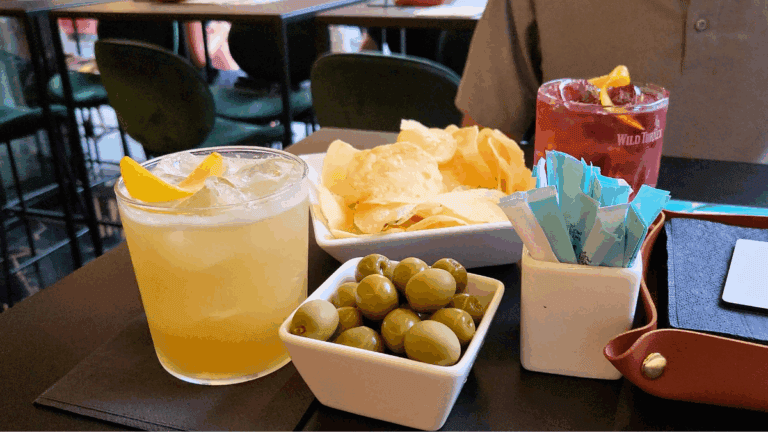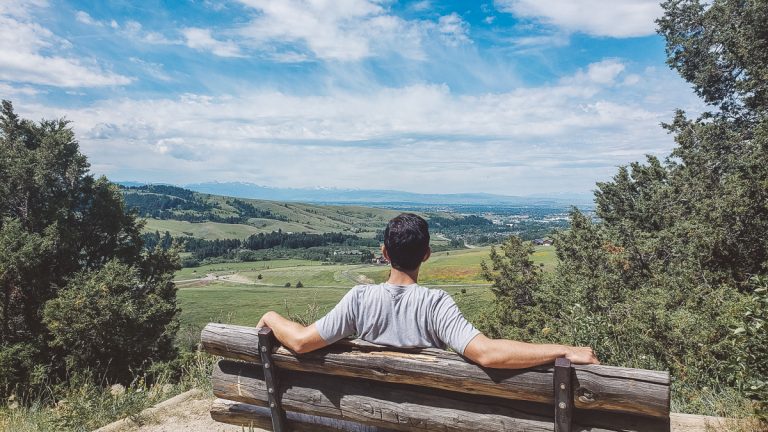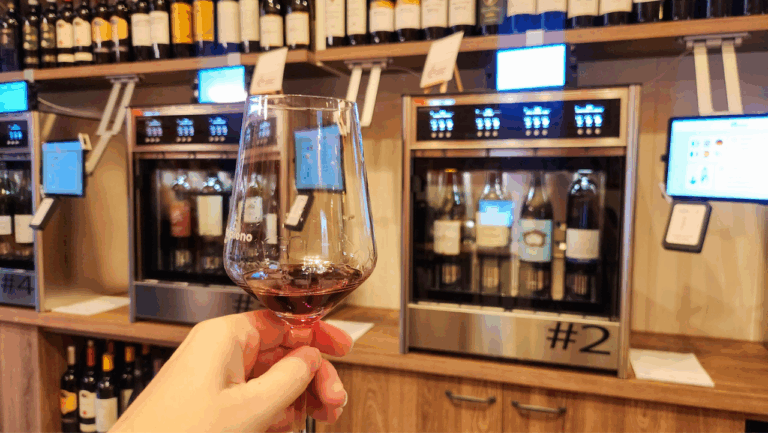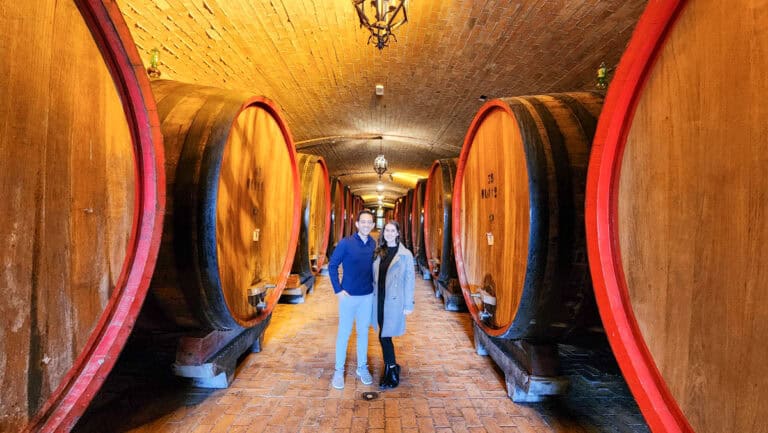A Weekend In Venice, Italy: Guide for First Time Visitors
Venice may be one of the most photographed cities in the world, but there’s more to it than canals and gondolas. We spent a weekend in Venice diving beyond the typical postcard shots to discover local wine, unexpected quiet corners, and experiences that feel deeply Venetian, without the crowds.
From snacking on cicchetti in cozy bacari to wandering ghost-quiet alleys by moonlight, Venice proves that the best memories often come from slowing down, getting lost, and ditching the itinerary.
Whether it’s your first trip or your fifth, this guide will help you unlock the side of Venice most travelers don’t get to see.
We are fortunate that we live nearby in Bologna and can easily do a weekend in Venice via train.
Yes, Venice is CROWDED, but we think it’s worth it!
Quick Takeaways for a Weekend in Venice:
- Wander beyond the tourist path to uncover hidden gems
- Ride gondolas or budget-friendly traghetti for iconic views
- Eat cicchetti and sip local wine in cozy bacari bars
- Explore famous landmarks like St. Mark’s and Rialto Bridge
- Escape to colorful island villages like Murano and Burano
Boozing Abroad contains affiliate links throughout the site. If you choose to purchase items through these links, we will earn a small commission at NO extra cost to you. Read the full disclosure policy here**
A Brief History of Venice: Power, Trade, and Resilience on Water
Venice didn’t begin as a grand city, but as a refuge. In the 5th century, people fleeing invasions on the mainland escaped to the shallow, marshy islands of the Venetian Lagoon.
With no fresh water, little land, and no real infrastructure, survival seemed impossible, but the Venetians built a city anyway. They drove wooden piles deep into the mud, laid stone on top of them, and slowly transformed the lagoon into a thriving settlement.
By the 9th century, Venice was booming. Its location between East and West turned it into a global trading hub. Spices, silk, and glass flowed through its ports, along with ideas from the Byzantine Empire and the Islamic world.
Wealth from trade fueled the city’s rise, and with it came elaborate palaces, ornate churches, and some of the most breathtaking architecture in Europe.
At its height, the Republic of Venice commanded a powerful navy and controlled trade routes across the Mediterranean. It ruled Dalmatian coastlines, Greek islands, and even parts of Constantinople.
For over a millennium, it was one of the richest and most influential cities in the world.
That golden age began to fade when Napoleon arrived in 1797, ending the Venetian Republic. But while its political power collapsed, the beauty of Venice remained untouched.
Today, Venice feels like a city suspended in time, equal parts wonder and survival story. It’s a living museum of resilience, built on water, and anchored by centuries of history that still echo through its alleyways.
Our Detailed Map of Venice
HOW TO USE THIS MAP: To view the layers and see the names of the places on this map, click the tab in the top left corner. You can select the check marks to show or hide certain layers. If you select the icons on the map, you will get more information about the point of interest.
HOW TO SAVE THIS MAP: If you select the star icon next to the map name, you can save this map to your Google Maps account. To view it, open Google Maps in desktop or on your phone, select the menu button, go to “Your Places,” scroll to the right to Maps, and you will see this map.
Things to Do in Venice
St. Mark’s Square: The Heart of Venice

- Location: Piazza San Marco, Venice’s central square
- Best Time to Visit: Early morning or late evening for fewer crowds
- Tip: Bring waterproof shoes in the fall and winter – this square floods often
- Cost: Free to wander, but Basilica and Doge’s Palace have entrance fees
Piazza San Marco may be in every Venice guidebook, but there’s a reason. This grand, open-air square has been the spiritual and social center of the city since the 9th century, framed by iconic landmarks like St. Mark’s Basilica and the Doge’s Palace.
Despite the crowds and camera flashes, we still felt the magic during our weekend in Venice. The square glows differently depending on the time of day, early mornings are quiet and golden, while evenings feel like a dream with live music echoing off the stone.
Just beware of acqua alta (seasonal flooding) which can turn the square into a shallow lagoon. When that happens, locals roll out raised walkways and keep moving like it’s nothing.
You don’t need to spend hours here, but pausing to hear the bells chime while pigeons scatter across the marble still feels iconic for a reason.
Want to Explore St. Mark’s Without the Crowds?
If you’re overwhelmed by the lines at the Basilica or unsure how to get the most out of your time in the square, booking a guided tour can seriously upgrade the experience. Viator offers tons of great options, and most come with skip-the-line access, expert guides, and flexible cancellation (which we love).
Here are a few solid tours to consider:
Rialto Bridge: Venice’s Most Famous Crossing
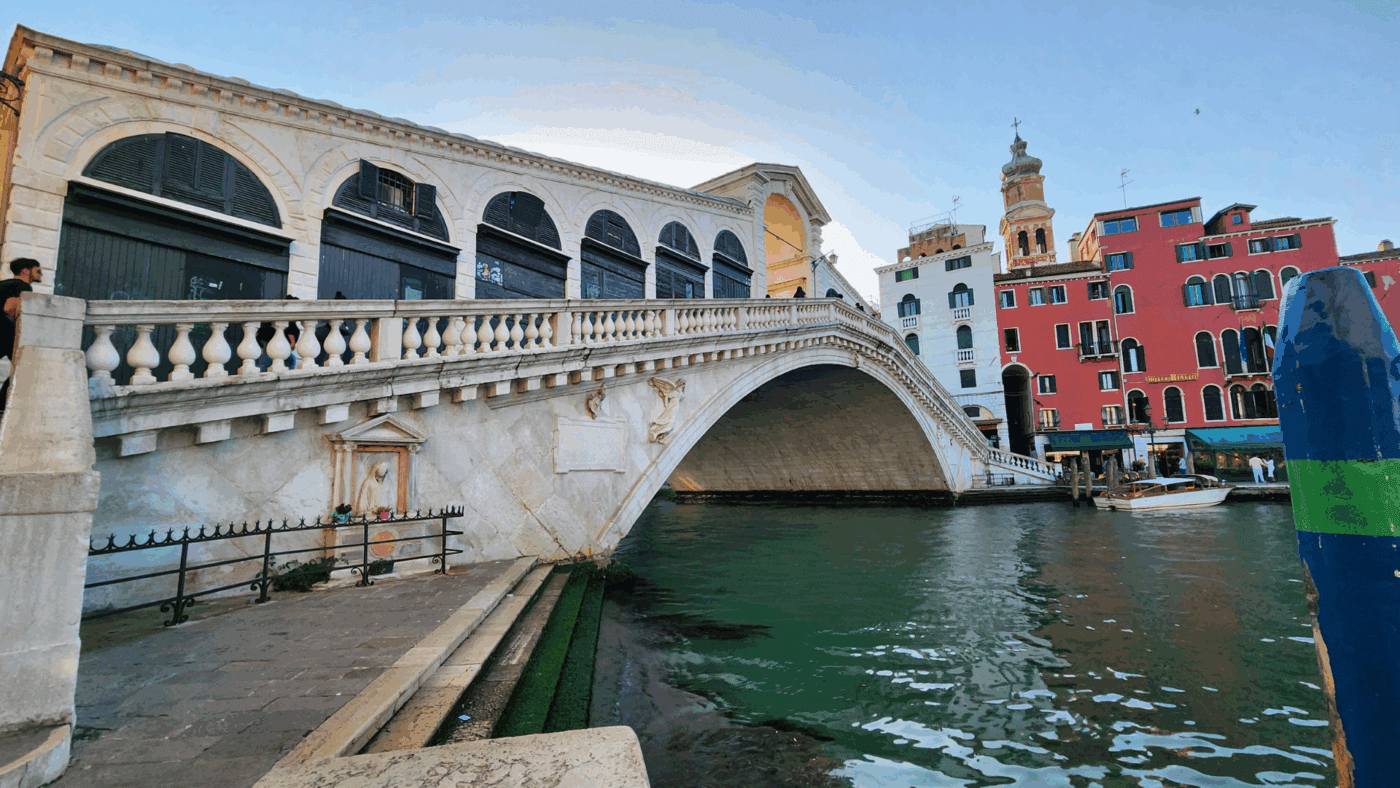
- Location: Spans the Grand Canal, connecting San Marco and San Polo
- Best Time to Visit: Early morning or golden hour
- Cost: Free to cross
- Tip: For photos without crowds, go at sunrise
- Atmosphere: Bustling, iconic, but surprisingly romantic at the right time
The Rialto Bridge isn’t just a tourist landmark – it’s a symbol of Venetian resilience and ingenuity. Originally built in 1173 as a floating pontoon bridge to connect the bustling districts of San Marco and San Polo, the bridge has seen multiple rebuilds.
The current stone version, completed in 1591, was a bold architectural gamble at the time. Engineers thought it would collapse under its own weight, but here it stands, centuries later, carrying both tourists and history across the Grand Canal.
In its prime, this was the financial heart of Venice. Picture spice merchants calling out prices, goldsmiths haggling over deals, and traders hauling goods from distant lands. Today, souvenir stalls have replaced the spice crates, but the spirit of commerce still lingers.
The bridge is lined with shops, but the real magic is in the view. Stand at the crest during sunrise or sunset, and the Grand Canal shimmers with a golden glow that makes the crowds fade into the background.
During the weekend in Venice, there will be crowds, so brace yourself if you go mid-day. If it feels a bit too chaotic during the day, wander a few minutes away. There are smaller, quieter bridges that offer similar views minus the hustle.
Canal Wandering: Getting Lost on Purpose
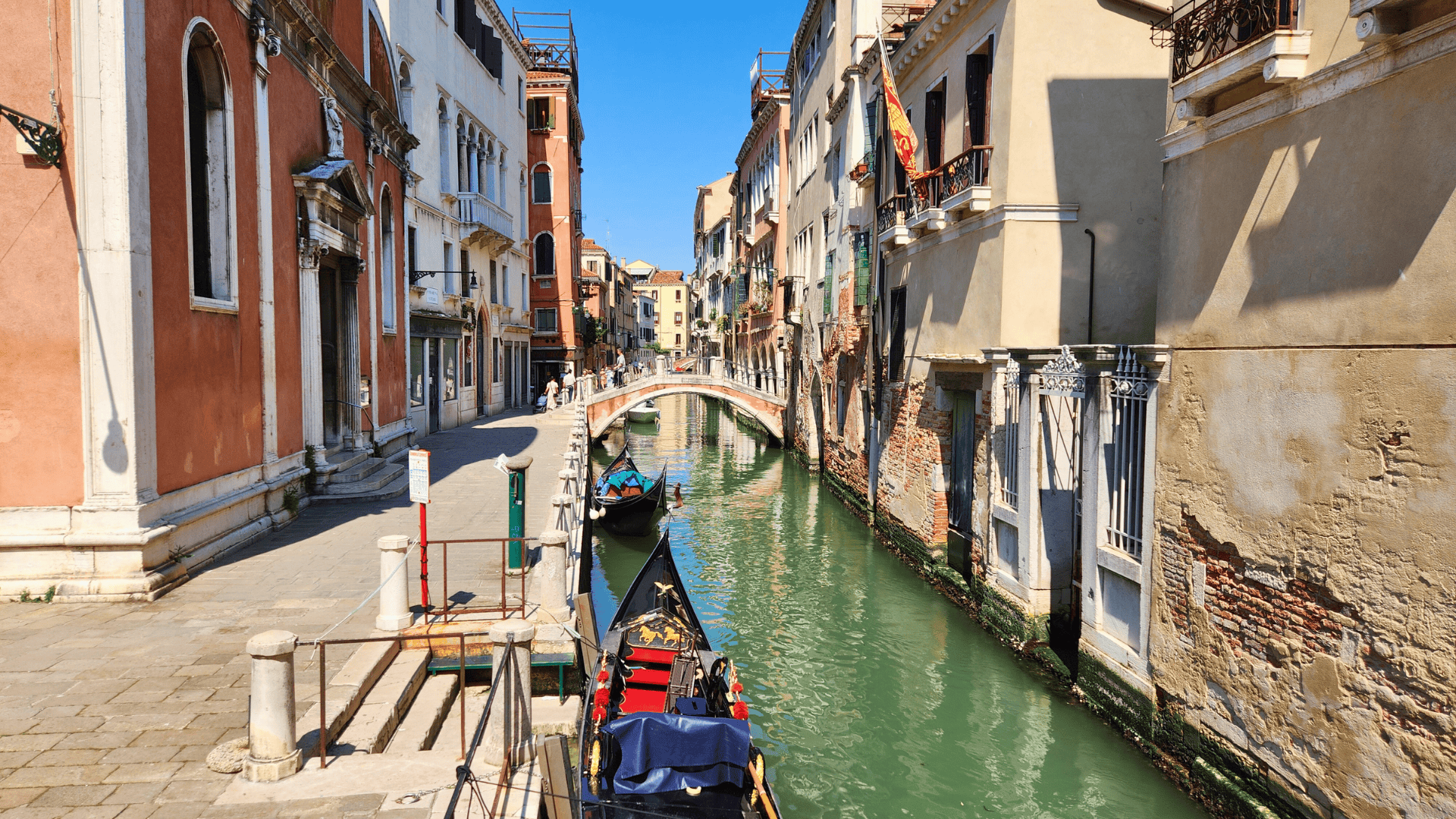
- Location: Everywhere
- Best Time: Early morning or late afternoon
- Cost: Free
- Tip: Turn off Google Maps for max magic. You can’t truly get lost – it’s an island.
Here’s your permission slip to ditch the plan. One of the best things to do in Venice is simply to wander. The alleys twist and turn, canals cut off your path, and just when you think you’re stuck, you find a charming square with a wine bar.
The architecture shifts with each sestiere. One moment you’re in a sleepy residential zone with locals sipping espresso, the next you’re standing in front of a palace or a bell tower you hadn’t planned to see.
Gondola Ride + Traghetto Crossings
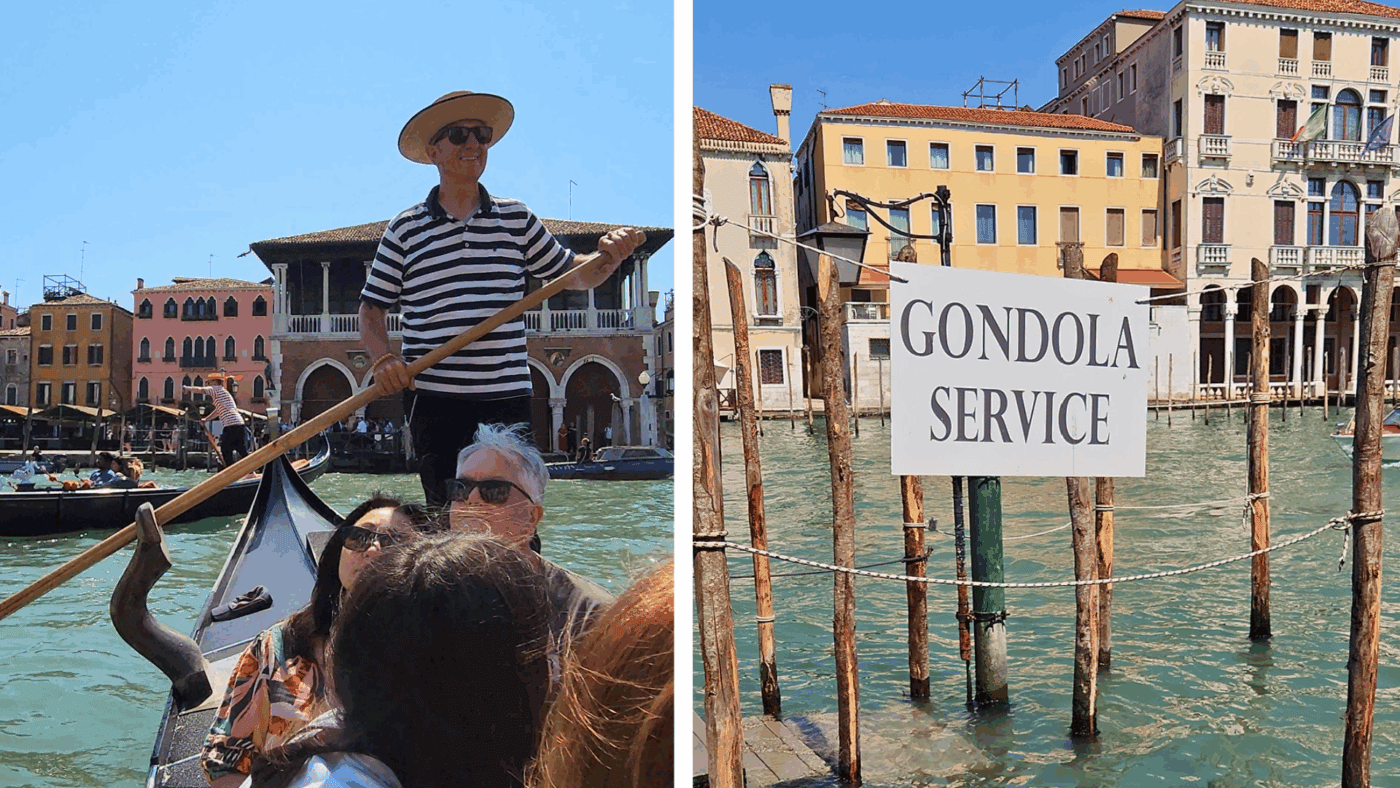
- Location: Throughout the city, especially along the Grand Canal
- Cost: €90 for 30 minutes (gondola), €2 per ride (traghetto)
- Duration: Gondolas ~30 mins, Traghetti ~2–3 mins
- Tip: Traghetti usually operate only during the day and are cash-only
A gondola ride is classic Venice, but it’ll cost you. Expect to pay around €90 for a 30-minute ride during the day. Romantic? Sure. Budget-friendly? Not so much.
If you still want that view-from-the-water experience, take a traghetto instead. These standing-room-only gondola ferries are how locals cross the Grand Canal without detouring to a bridge. No serenade, no frills – just €2 and a few magical minutes gliding through Venice.
You’ll likely be standing next to a grandma holding groceries. That’s the charm.
In short, ride a traghetto for the view and experience. Ride a gondola for the vibes. Both are 100% Venice.
Rialto Market: Venice’s Oldest Market
- Location: Campo della Pescheria near Rialto Bridge
- Hours: 7 AM – 1 PM, closed Sundays
- Cost: Free to browse
- Tip: Visit before 11 AM for the full experience
- Bonus: Great place to spot seasonal produce and fresh lagoon seafood
This isn’t your average tourist market. Mercato di Rialto has been Venice’s main food market since 1097, and it’s still where locals shop for the freshest fish, herbs, fruits, and veggies.
The fish section (Pescheria) is wild in the best way, octopus, eel, glistening branzino, all packed in ice and bartered over in fast-paced Venetian dialect. The produce stalls? A color explosion of whatever’s in season. It’s loud, it’s fast, and it’s deliciously unfiltered.
Come early to catch the action and maybe grab a snack at one of the nearby cicchetti bars afterward.
Fondamenta della Misericordia: Canal Walk for Wine and Cicchetti

- Location: Cannaregio district, stretching from Ponte delle Guglie toward Madonna dell’Orto
- Best Time to Visit: Around golden hour (sunset) when locals are out for aperitivo
- Cost: Varies by bar, but cicchetti usually range from €1–€3 each, and wine is around €3–€5 a glass
- Tip: Get your drink to go and sit along the canal
For a more local vibe, head to Fondamenta della Misericordia, a relaxed canal-side street in the Cannaregio district. This is where Venetians go to unwind after work, and it’s a great place to soak up authentic city life.
The area is lined with casual bars and bacari serving up local wines and plates of cicchetti (see below section).
Come around sunset, grab a spritz or a glass of wine, and let the evening unfold. It’s the kind of spot where plans don’t matter, and the best parts of Venice reveal themselves slowly. We liked it so much that went back both nights during our weekend in Venice.
Aperitivos and Cicchetti
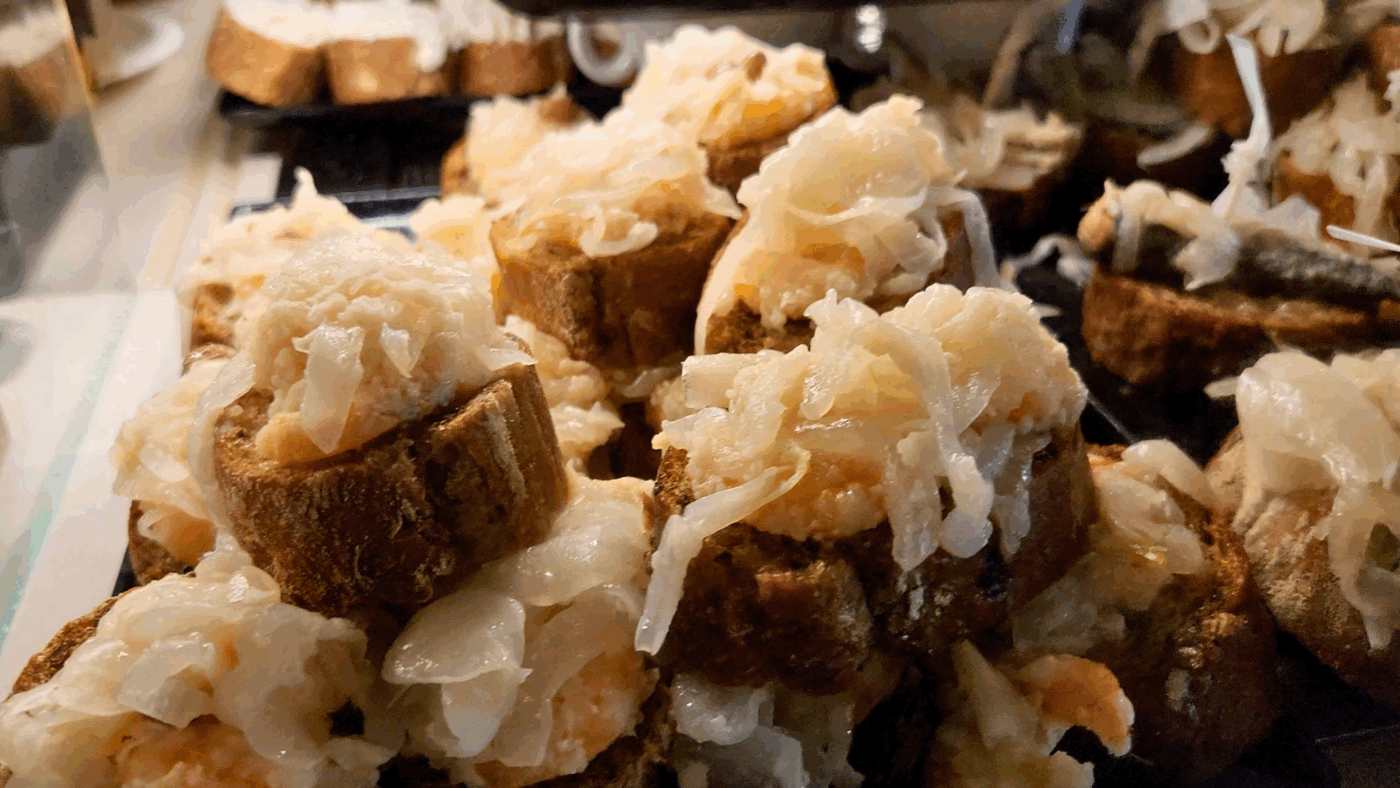
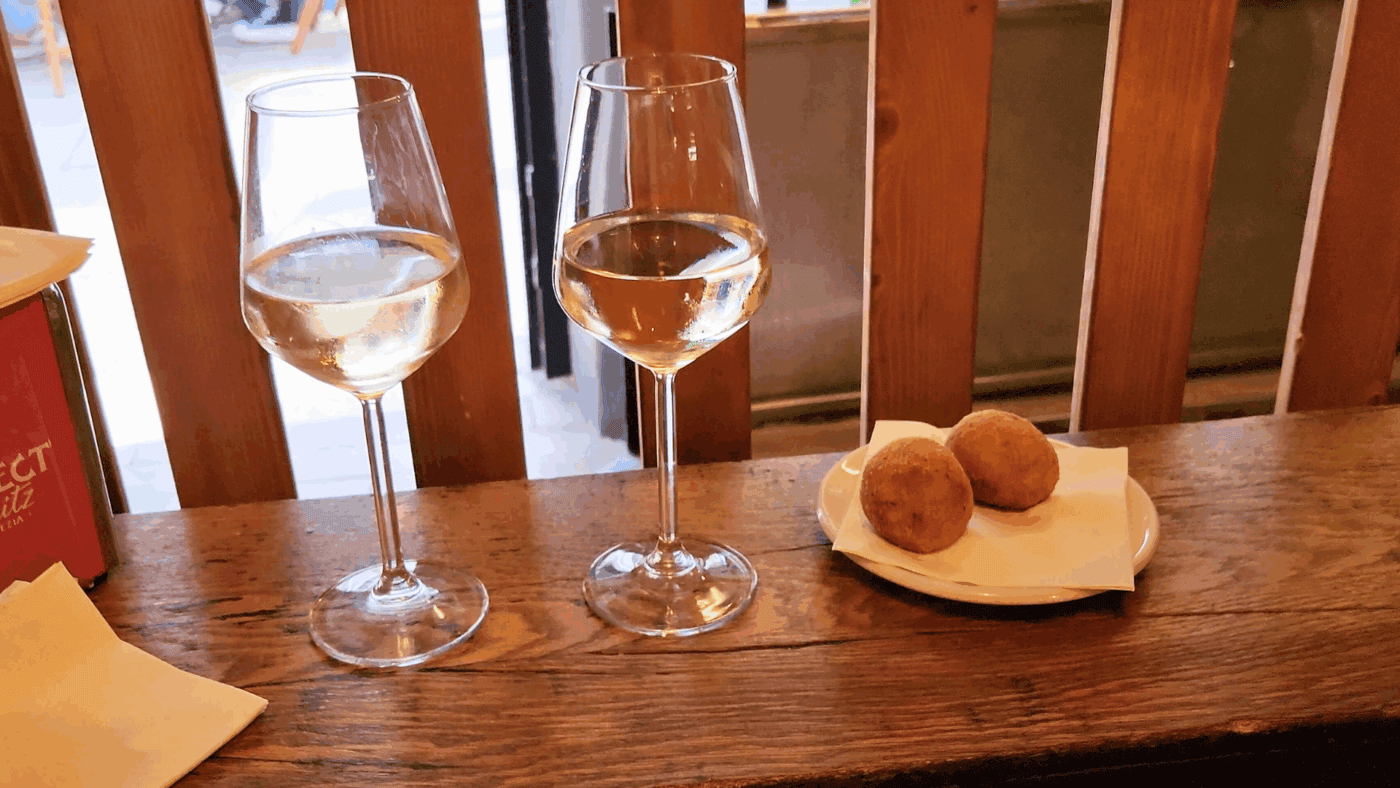
- What: Cicchetti = Venetian-style tapas
- Cost: ~€1.50–3 per bite, wine by the glass ~€3–5
- When: Best enjoyed between 5-8 PM (aperitivo hour)
- Tip: Order at the bar like a local, eat standing up if it’s crowded
Cicchetti are small but mighty. Think: creamy baccalà on toast, fried zucchini flowers, spicy meatballs, and mini sandwiches, all meant to be washed down with local wine in cozy bacari (traditional wine bars).
Our favorite stops included:
- Bacaro all’Imbuto
- Bacaro Al Momoleto De Le Voie
- Alla Fonda
- Vino Vero
- Bacaro ae Bricoe
For a sit-down meal, Osteria Da Alberto hits the sweet spot between casual and classic. You’ll find hearty plates of seafood risotto, seasonal pastas, and house wine that pairs perfectly with whatever you order.
La Terrazza Rooftop Bar
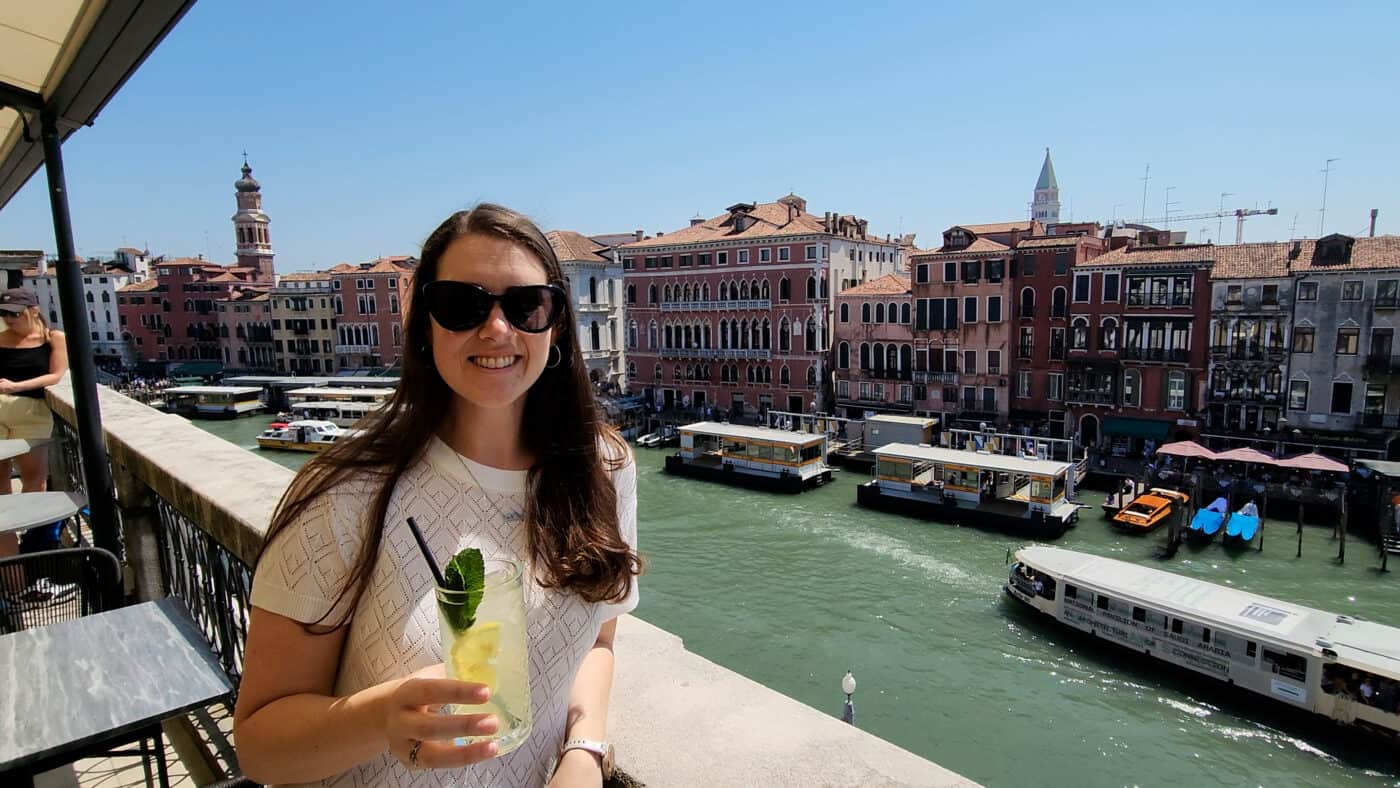
- Location: H10 Palazzo Canova, near the Rialto Bridge
- Best Time to Visit: Early afternoon for sunshine and shorter wait times
- Cost: Cocktails start around €16; Wine and Beer or non-alcoholics get you the view for less
This isn’t your budget-friendly spritz stop, but the view makes up for it.
La Terrazza sits right above the Grand Canal with a direct line of sight to the Rialto Bridge. The constant motion of boats below and golden reflections off the water turn this spot into something pretty magical.
It’s the kind of place where you don’t rush your drink. You sit, sip slowly, and let Venice put on a show. While many rooftop cocktail bars in Venice don’t open until the evening, La Terrazza opens earlier in the day, making it a solid daytime option when you want prosecco with a view.
Sure, the prices are high. But when the backdrop is this iconic, it kind of feels like you’re paying for the view and the drink is just the bonus.
Harry’s Bar & The Bellini
- Location: Calle Vallaresso, just off St. Mark’s Square near the Grand Canal
- Best Time to Visit: Late afternoon for a pre-dinner drink or early evening before it gets crowded
- Cost: The famous Bellini is about €22; we opted NOT to for this reason
If you’ve ever sipped a Bellini anywhere in the world, you’ve got Harry’s Bar to thank.
This legendary spot opened in 1931 and quickly became a magnet for creative legends: Hemingway, Capote, and Bogart all drank here. But Harry’s didn’t just serve drink – it invented one.
The Bellini, made from fresh white peach purée and Prosecco, was created in the 1940s by Giuseppe Cipriani. Named after the rosy glow of a Renaissance painting, it’s since become a signature Venetian cocktail.
You’ll find versions everywhere in Venice and beyond, Rossinis, Puccinis, Tintorettos, but nothing beats the original, served in the place it was born.
Just brace yourself: like most icons, it comes with a luxury price tag.
To be transparent, neither of us are big Bellini fans and we couldn’t accept the cost of a drink that we don’t really care for BUT, if you are a fan, this would be a cool experience. Also note, you can get a Bellini almost anywhere else in Venice for a fraction of that price.
Hidden Gems of Venice
Scala Contarini del Bovolo: Venice’s Hidden Spiral Staircase
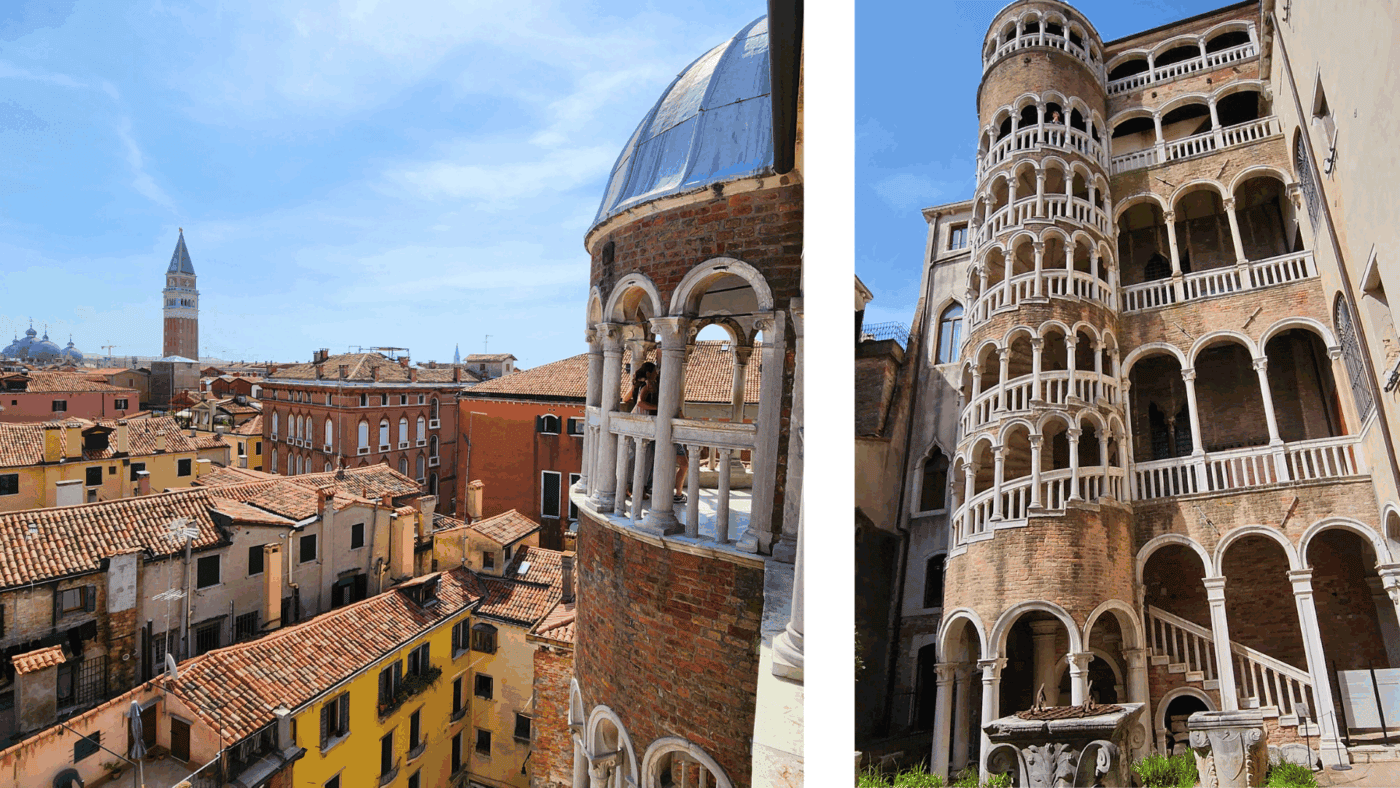
- Location: Corte Contarini del Bovolo, a short walk from Campo Manin (central Venice)
- The entrance is a bit hidden- use Google Maps and follow signs from Campo Manin
- Best Time to Visit: Early morning or late afternoon for soft light and fewer visitors
- Cost: €9+ per person to climb the tower (viewing the courtyard is free)
- Tips: Buy your ticket online in advance to skip the ticket line
Tucked deep in a quiet courtyard near Piazza San Marco, the Scala Contarini del Bovolo is one of Venice’s most enchanting architectural secrets. This 15th-century spiral staircase winds around a slender cylindrical tower, creating a fairytale-like structure that feels worlds away from the busy canals nearby.
Originally part of a fontego house, a blend of noble residence and merchant business, the building was home to the prominent Contarini family.
In 1499, Pietro Contarini added the staircase, known as the bovolo (meaning “snail” in Venetian), to elevate the family’s home both literally and symbolically.
The staircase stretches 26 meters high with 80 steps, wrapping through a series of arched galleries made of stone and brick. While you can admire it for free from the courtyard, climbing to the top offers one of the most tranquil views in all of Venice.
Ticket Info: Book your entry here
Why It’s Worth the Climb
The steps aren’t difficult, and the reward at the top is a peaceful rooftop view of Venice you won’t get anywhere else. Unlike the crowded bell towers or bridges, the vista here is quiet and personal.
You’ll see terracotta rooftops, the bell towers of San Marco, and the curve of the Grand Canal, all without the usual crowds. It’s a spot where Venice feels like a dream, suspended in time.
Whether you climb it or simply take a peek from the courtyard, this is one of the few places that still feels like it’s keeping a secret.
Libreria Acqua Alta: The Bookstore That Floats

- Location: Calle Longa Santa Maria Formosa
- Hours: Usually 9 AM to 8 PM
- Cost: Free to enter
- Tip: Head to the back for the famous “staircase” of books
- Bonus: Yes, there are cats
If Hogwarts opened a bookstore in Venice, this would be it. Libreria Acqua Alta is a wildly charming and chaotic little shop where books are stacked in bathtubs, boats, and even an old gondola. Why? Because Venice floods and the owner got creative.
Resident cats nap in corners and on covers, and narrow walkways are packed with everything from Italian novels to English travel memoirs. It’s more than a bookstore, it’s an experience. Don’t leave without climbing the stairway of books in the courtyard for a photo-worthy view of the canal.
Palazzo Tetta: The Most Photogenic Corner in Venice
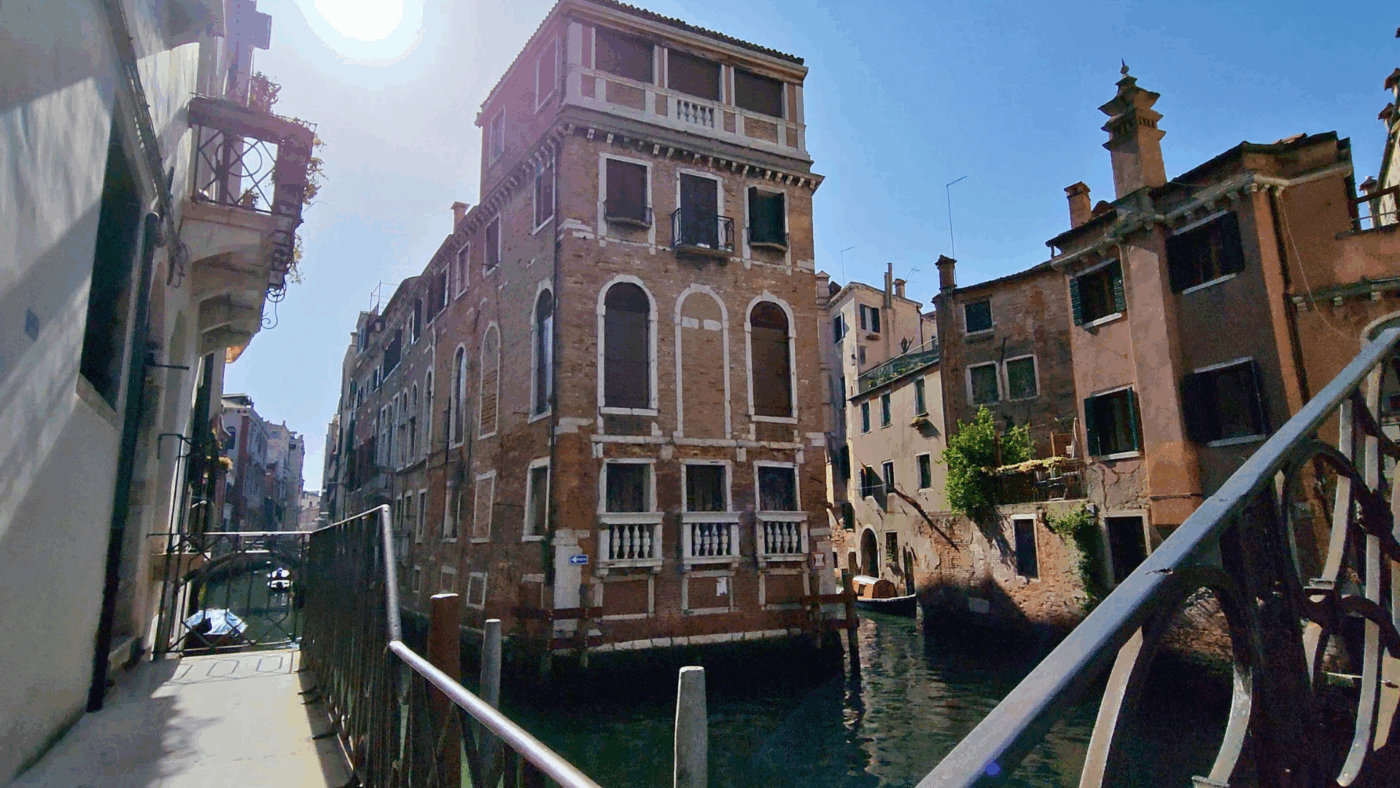
- Location: Fondamenta de l’Osmarin
- Hours: Not open to the public
- Cost: Free to view
- Tip: Best photos are from the Ponte dei Conzafelzi bridge across the canal
- Setting: Surrounded by water on three sides
Palazzo Tetta is one of those blink-and-you-miss-it spots that make Venice feel like a dream. Tucked into a tight bend of the canal and flanked by water on three sides, this Gothic-style palazzo is a favorite of photographers and architecture buffs.
While you can’t go inside, the setting alone feels unreal. Boats drift past pastel walls while reflections ripple like oil paintings. It’s a quiet, stunning moment in a city full of visual overload.
Ponte Chiodo: The Bridge That Time Forgot
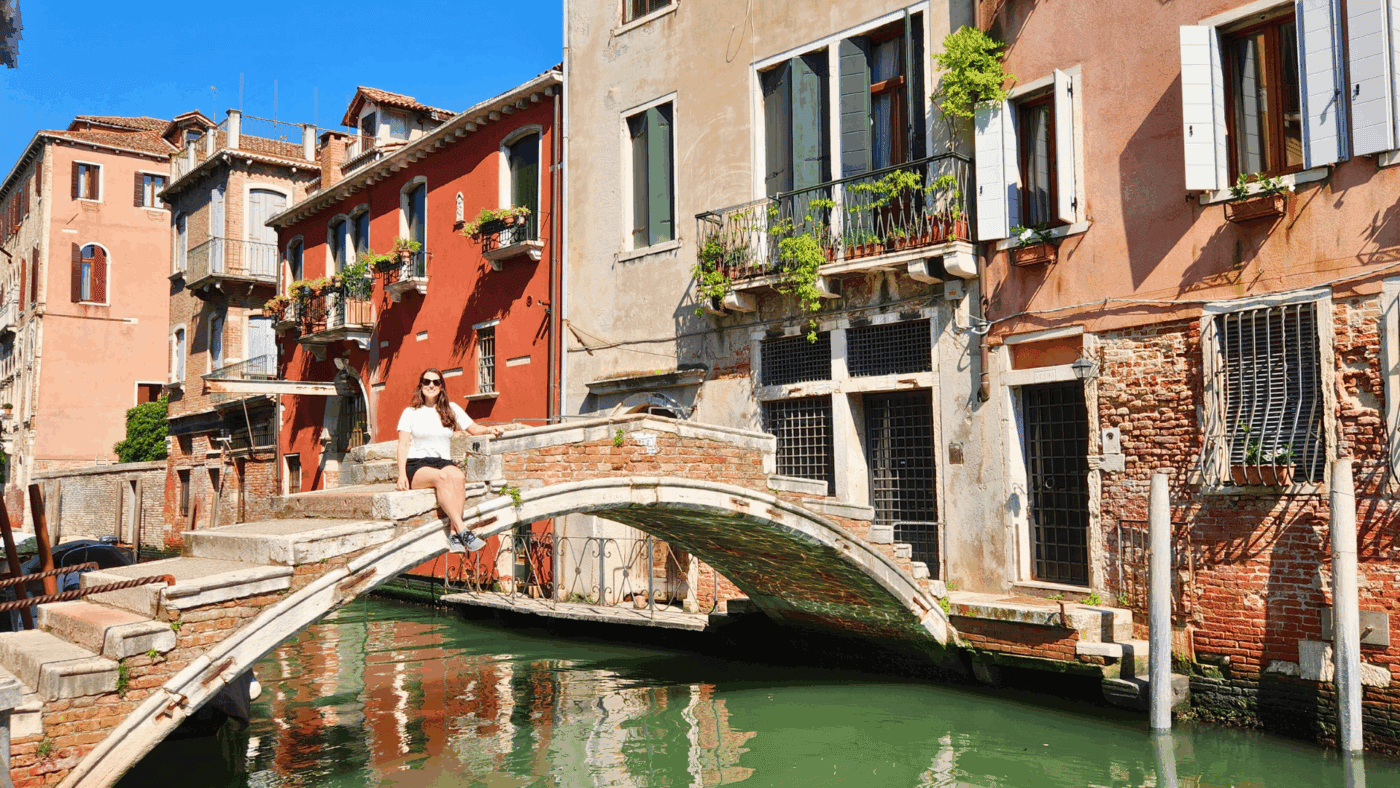
- Location: Cannaregio district
- Hours: Always accessible
- Cost: Free
- Warning: No railing so step carefully
- Note: Leads to a private residence
Most of Venice’s original bridges didn’t have railings. Only one still stands like that, Ponte Chiodo. This no-frills, blink-and-you’ll-miss-it bridge in Cannaregio offers a literal step back in time.
It’s small, unassuming, and quietly beautiful. No fanfare, no crowds -just a short stone arch over a peaceful canal. It’s a five-minute detour that makes you feel like you’ve uncovered a secret.
Day Trips from Venice: Murano & Burano
Murano: The Glass Island
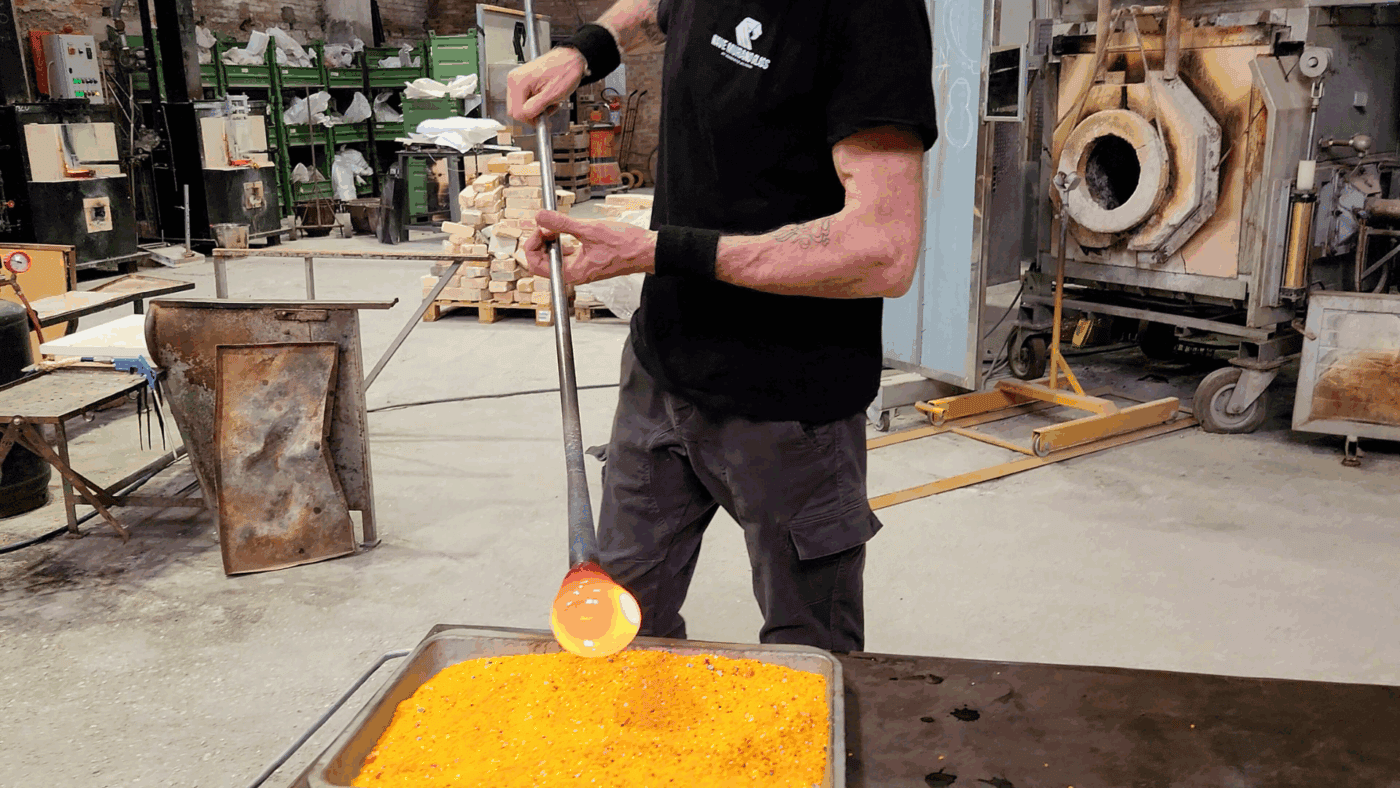
- Location: ~10-minute vaporetto ride from Venice (Line 4.1, 4.2, or 3)
- Hours: Most workshops open 10 AM–5 PM
- Cost: Free to wander, demo fees vary
- Tip: Visit a glassblowing demo at a local furnace (forno)
Murano has been the beating heart of Venetian glassmaking for over 700 years. In 1291, Venice moved all its glassmakers here to reduce the fire risk and the result? A small island filled with centuries of craftsmanship and fiery forges.
Pop into one of the many family-run workshops or visit the Museo del Vetro (Glass Museum) to learn how this intricate art form has evolved.
Burano: Colorful & Calm
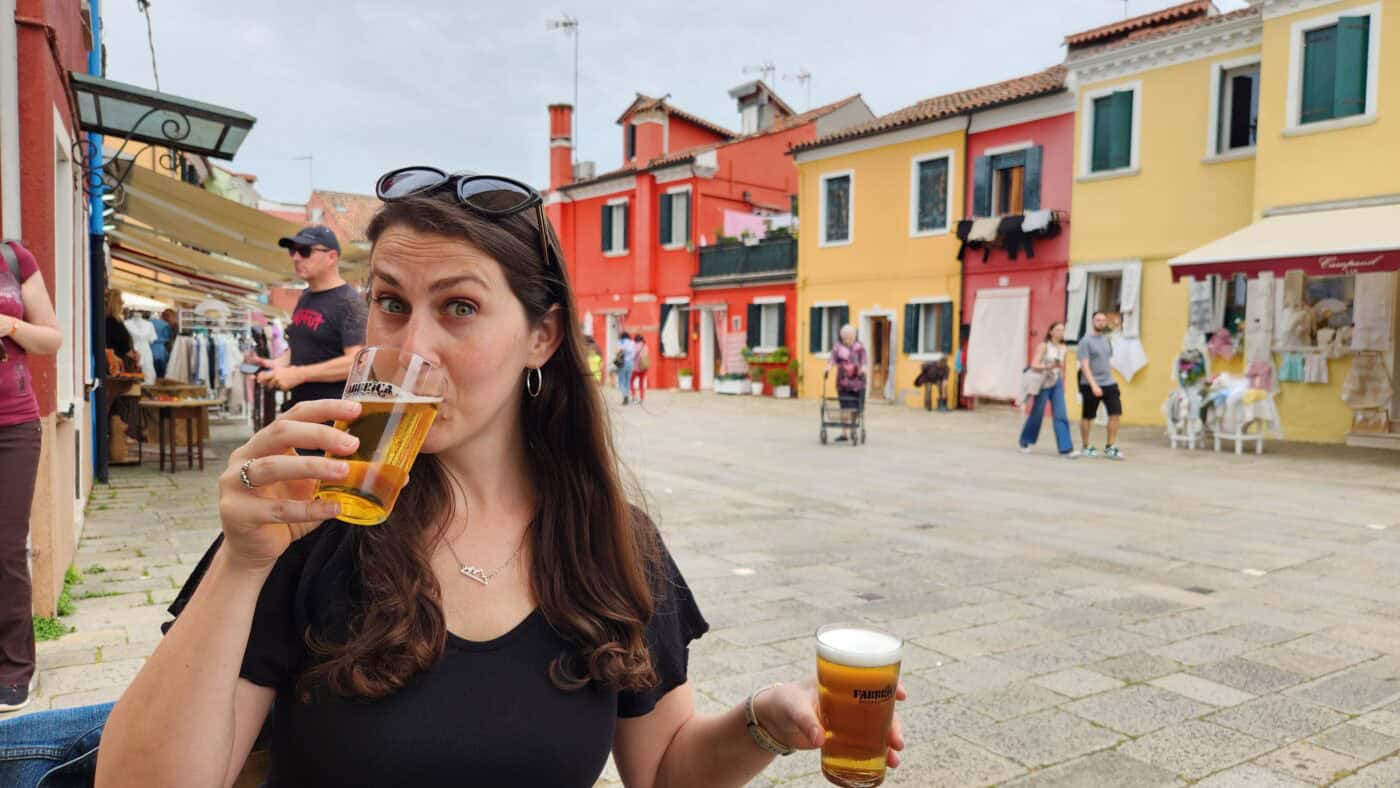
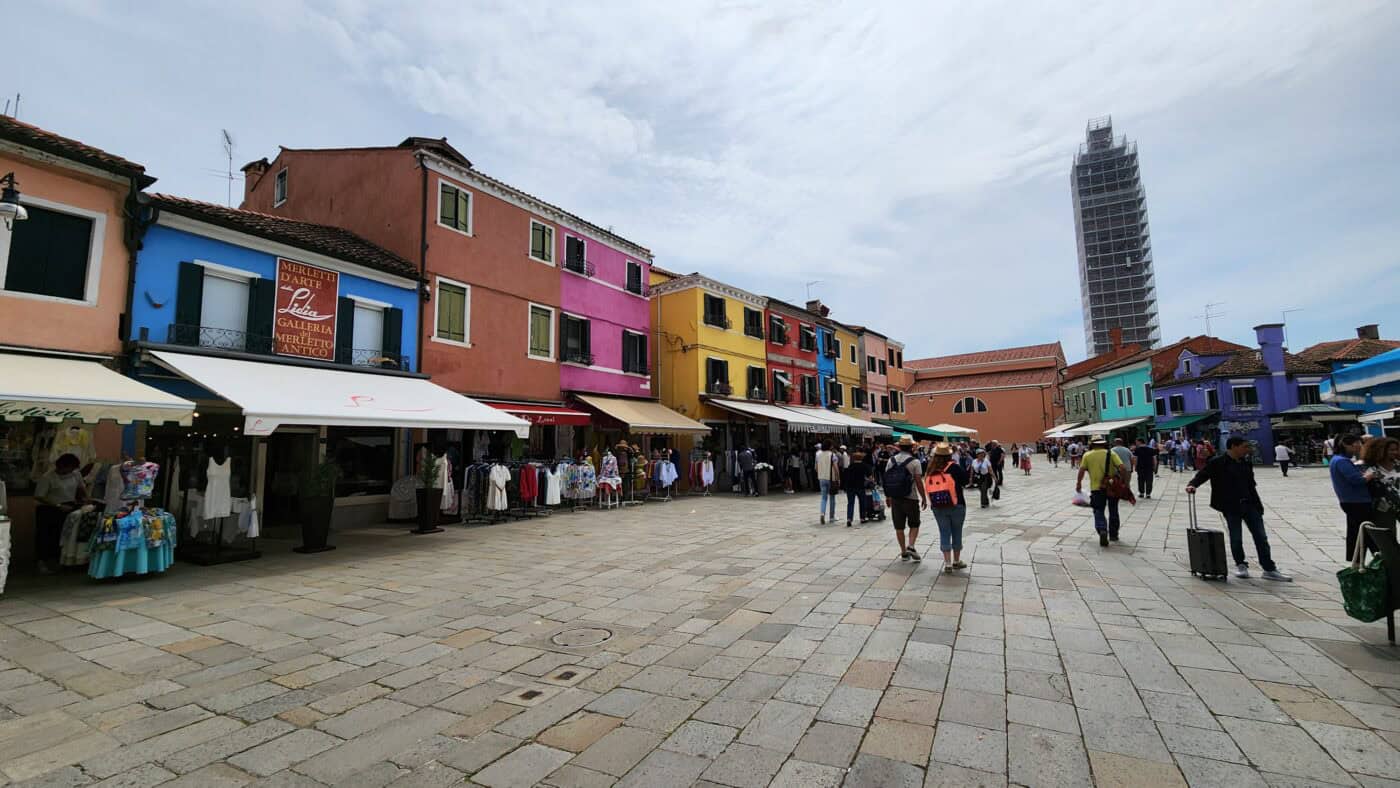
- Location: ~45-minute vaporetto ride from Venice (Line 12)
- Best Time: Mornings or late afternoons for soft light and fewer crowds
- Highlight: Traditional lace shops and Scuola dei Merletti (Lace Museum)
- Tip: You only need 1-2 hours here and you can experience most of what there is to see
Burano is Venice’s most photogenic neighbor. Every house is painted a different vibrant color – legend says it helped fishermen spot their homes in the fog. These days, it’s Instagram gold.
But the island’s charm goes deeper. Burano has a long history of lace-making, with a handful of shops still preserving the tradition. It’s quiet, slow, and full of stories.
Watch: Our Weekend in Venice (Full Travel Vlog)
Want to see what Venice really looks like beyond the postcards?
We filmed our full weekend exploring the city – no tours, no strict plans. Just local wine, hidden corners, and all the scenic chaos Venice has to offer.
FAQ: Visiting Venice
How do I get around Venice?
The city is car-free. You’ll walk or take the vaporetto (water bus). For short hops across the Grand Canal, try a traghetto gondola for just €2.
How long should I stay in Venice?
2–3 days is ideal for hitting highlights while leaving room to wander. If you want to explore the islands (Murano, Burano, Torcello), consider adding an extra day.
Is Venice expensive?
It can be, but you can save by staying outside the main tourist zones, skipping pricey gondola rides for traghetti, and eating cicchetti instead of sit-down meals every night.
What should I pack for Venice?
Comfy walking shoes, layers (even in summer), and a waterproof jacket – Venice floods unexpectedly. Bonus: Bring a reusable water bottle. The city has free public fountains with clean drinking water.
When is the best time to visit Venice?
Late spring (May–early June) or early fall (September-October) for fewer crowds and pleasant weather. Avoid peak summer if you don’t like heat + heavy tourism.
Venice Weekend Tours Worth Booking
Viator is a massive online hub for all kinds of tours and excursions. You can find tons of options, like cooking classes, walking tours, street art lessons, and more, in cities all over the world. It’s a great resource for discovering specific tours no matter where you’re headed.
If you prefer a little structure, here are some top-rated tours that’ll upgrade your Venice experience:
Venice Walking Tour + Gondola Ride
This 2-hour guided intro to the city’s big hitters: St. Mark’s, Doge’s Palace, and hidden alleys you’d probably miss. Throw in the gondola ride and this is a great option for first-time visitors!
>> Click here to see current prices and availability
Cicchetti & Wine Crawl
Skip the tourist traps and taste your way through Venice with a local. You’ll visit authentic bacari, try regional wines, and snack like a true Venetian.
Looking for more tour options? Browse all Viator tours in Venice here
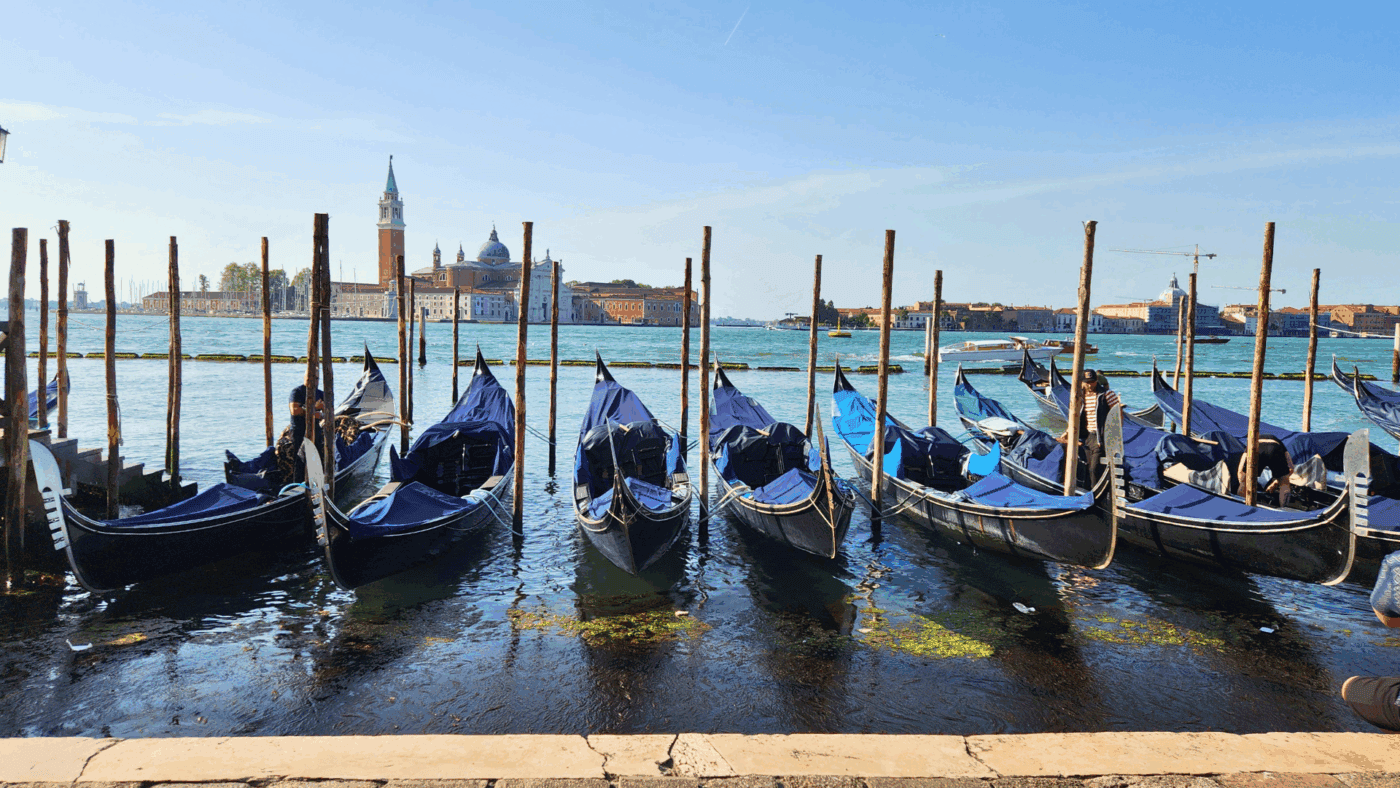
While it’s hard not to run around trying to see everything in a weekend in Venice, this city will reward those who slow down.
Sure, you’ll see the highlights, St. Mark’s, gondolas, canals, but it’s the unplanned moments that leave the biggest impression. A quiet bridge at golden hour. A €2 traghetto gliding across the Grand Canal. A glass of wine in a bacaro full of locals laughing over plates of cicchetti.
Venice doesn’t need you to rush. It just needs you to notice.
Whether you’re here for the weekend or longer, trust your feet, follow the water, and let this magical city show you its secrets.
Loved this Venice guide? There’s more where that came from. Dive into more of our Italy content below:
- 9 Amazing Things to do in Trieste, Italy – Castles, sea views and unique cocktails
- One Day in Bologna – Wine, Food, and Porticoes
- Travel Guide to Dozza, Italy – Street Art, Castles, and Wine Tastings
- Florence, Italy – the Ultimate 3 day Travel Itinerary
- What to do in 3 days in Rome – Can’t miss spots and sips
Looking for even more Italy guides? We’ve got a bunch you can browse here.
Ready to spend a weekend in Venice? Read hotel reviews on TripAdvisor then book your room here!
Don’t forget to pick up a travel guidebook for your other adventures.
Love this guide? Have questions? Get in touch with us on Facebook | YouTube | Instagram | Pinterest


